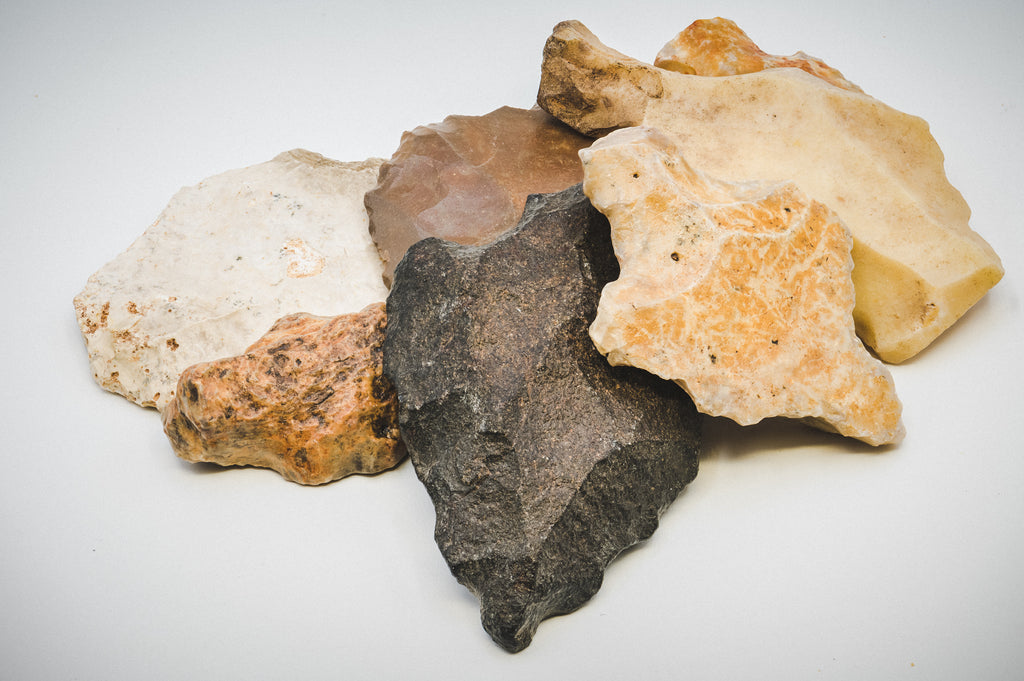Aterianische Werkzeuge







Aterianische Werkzeuge





























Oben: Vorderseite der Musterkarte
Die Herstellung von Werkzeugen ist ein entscheidender Bestandteil der menschlichen Kulturentwicklung und unterscheidet uns von anderen Lebewesen. Schon früh in der Menschheitsgeschichte, mitten im Paläolithikum, entwickelte sich in Nordafrika eine neue technologische Kultur: die Aterianer. Diese Gruppe ist heute für ihre fortschrittlichen Techniken und die Differenzierung ihrer Werkzeuge bekannt. Durch die Untersuchung der Hinterlassenschaften der Aterianer können wir viel über ihre Lebensweise lernen.

Oben: Eine Auswahl an Aterian-Werkzeugen. Beachten Sie, dass Größe, Form und Farbe variieren.
Bei diesem Exemplar handelt es sich um ein vollständiges aterisches Werkzeug, wie es in Nordafrika gefunden wurde.
Jedes einzelne Werkzeug wird in einer klassischen Riker-Vitrine mit Glasplatte und den Maßen 4 1/2 x 3 1/2 Zoll präsentiert. Außerdem liegt eine kleine Informationskarte bei, die gleichzeitig als Echtheitszertifikat dient.
Bitte beachten: Farbe, Größe und Form variieren je nach Stein stark. Wie bei vielen tausend Jahren alten Steinwerkzeugen zu erwarten, variiert auch der Zustand, da die meisten im Laufe der Zeit abgenutzt sind.

About Aterian Tools and Culture
"A paleolithic group collectively or individually endowed intellectually beyond its contemporaries," ~ Gertrude Caton Thompson

Above: Rock paintings in Tadrart Acacus region of Libya dated from 12,000 BC to 100 AD. There are paintings and carvings of animals such as giraffes and elephants reflecting the dramatic climatic changes in the area. (Source: Luca Galuzzi)
The first tools classified as part of the Aterian culture were found at the Bir el Ater site in Morocco. These stone tools date back as far as 150,000 years old, near the beginning of the last interglacial period. They are most commonly defined by their leaf shape, bifacial workings, and the tang or stem at the back of the tool.
Since any organic material that was a part of the tools like wood or sinew would have decayed over time, we can only study the stone portions of the tools. The tanged stems found on the stones tell us that they were hafted into wooden rods, an advanced technique for the time. The tang is inserted into a handle, giving the tool more leverage and reach. Hafting allowed for larger and more complex tools, as one could have the strength of a stone edge with a handle made of simpler material. This technique could have been used to create spears or even early arrows.
Although some of the Aterian tools were used as weaponry, researchers believe that many were actually scraping and cutting tools for preparing hides, plants, and meat. Some of the more rounded edge tools fall into this category and analysis of these tools show evidence of frequent sharpening and reshaping by the Aterians. This constant upkeep is seen most often in tools that were used for routine tasks, like knives, choppers, and scrapers.
It’s thought that the Aterians gathered resources from a wide variety of sources, drawing on the sea as much as hunting and foraging. For each activity they had different tools and techniques. This differentiation is early evidence of a modern way of human thought, swapping out methods for each situation to improve efficiency. It’s possible that this behavior gave the Aterians an edge over their Neanderthal neighbors in Eurasia. The Aterian stone culture disappeared around 20,000 years ago, but not before expanding beyond North Africa and possibly across the Mediterranean.
Further Reading
Garcea, Elena A. A., editor. “The Spread of Aterian Peoples in North Africa.” South-Eastern Mediterranean Peoples Between 130,000 and 10,000 Years Ago, by Nick Barton et al., Oxbow Books, Oxford; Oakville, 2010, pp. 37–53.
Iovita, Radu. “Shape Variation in Aterian Tanged Tools and the Origins of Projectile Technology: A Morphometric Perspective on Stone Tool Function.” PLoS ONE, vol. 6, no. 12, 2011, doi:10.1371/journal.pone.0029029.
 Above: Back of the Specimen Card
Above: Back of the Specimen Card









